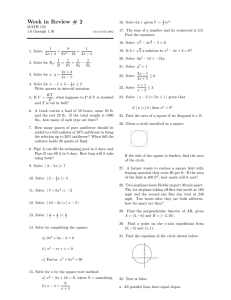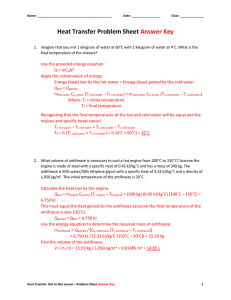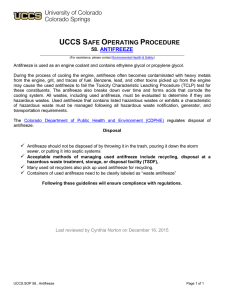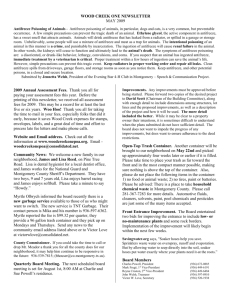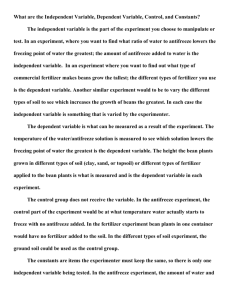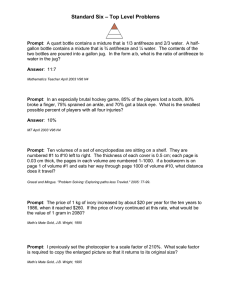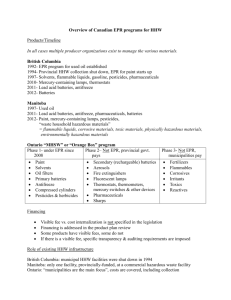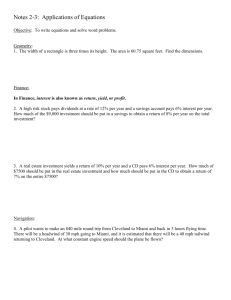Automotive lead-acid batteries are found at all USDA Forest Service... All lead-acid batteries contain lead and sulfuric acid, both regulated...
advertisement
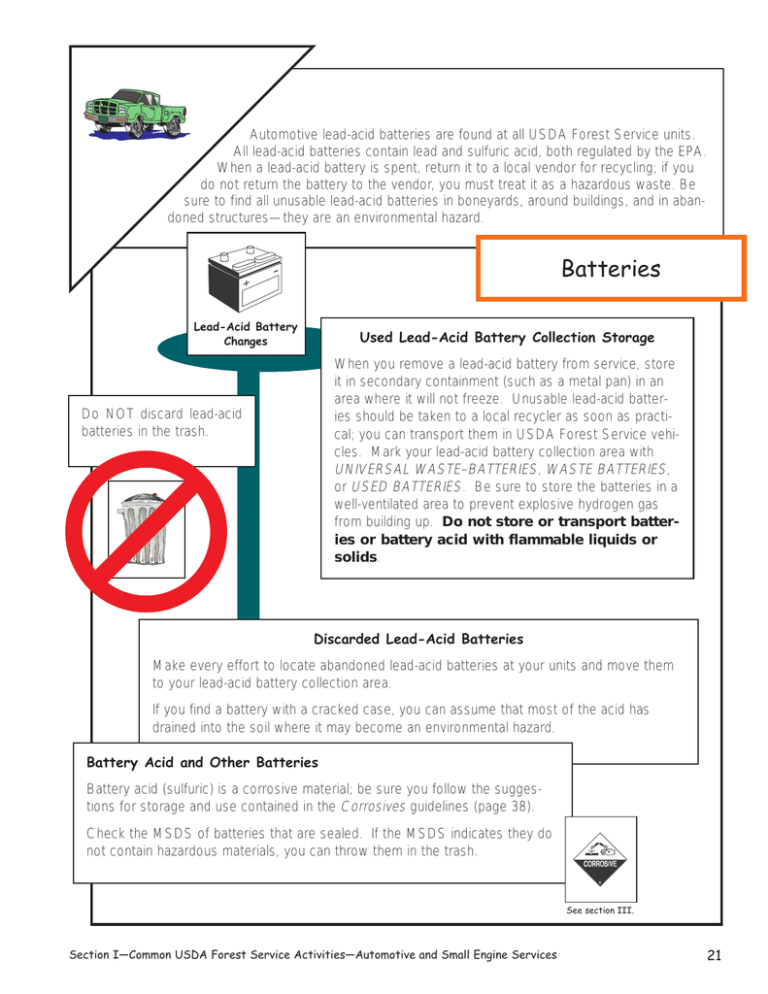
Automotive lead-acid batteries are found at all USDA Forest Service units. All lead-acid batteries contain lead and sulfuric acid, both regulated by the EPA. When a lead-acid battery is spent, return it to a local vendor for recycling; if you do not return the battery to the vendor, you must treat it as a hazardous waste. Be sure to find all unusable lead-acid batteries in boneyards, around buildings, and in abandoned structures—they are an environmental hazard. Batteries Lead-Acid Battery Changes Used Lead-Acid Battery Collection Storage When you remove a lead-acid battery from service, store it in secondary containment (such as a metal pan) in an area where it will not freeze. Unusable lead-acid batteries should be taken to a local recycler as soon as practical; you can transport them in USDA Forest Service vehicles. Mark your lead-acid battery collection area with UNIVERSAL WASTE–BATTERIES, WASTE BATTERIES, or USED BATTERIES. Be sure to store the batteries in a well-ventilated area to prevent explosive hydrogen gas from building up. Do not store or transport batteries or battery acid with flammable liquids or solids. Do NOT discard lead-acid batteries in the trash. Discarded Lead-Acid Batteries Make every effort to locate abandoned lead-acid batteries at your units and move them to your lead-acid battery collection area. If you find a battery with a cracked case, you can assume that most of the acid has drained into the soil where it may become an environmental hazard. Battery Acid and Other Batteries Battery acid (sulfuric) is a corrosive material; be sure you follow the suggestions for storage and use contained in the Corrosives guidelines (page 38). Check the MSDS of batteries that are sealed. If the MSDS indicates they do not contain hazardous materials, you can throw them in the trash. See section III. Section I—Common USDA Forest Service Activities—Automotive and Small Engine Services 21 Used tires can be found in many USDA Forest Service boneyards. Used tires present a health concern because they can be a breeding ground for insects. Large quantities of tires present a fire hazard. Check with your local fire marshal for specific local regulations. This guideline offers a few suggestions. Tire Changes Tire Changes Used Tire Collection When you remove tires from a vehicle, store them inside a structure, or cover them to prevent rainwater from providing a place where mosquitoes can breed. Recycle the tires when it is cost effective to do so. You may have to pay a small recycling fee per tire, but it is better to recycle the tires than to discard them in the landfill or keep them in your boneyard. Discarded Used Tires Make every effort to locate discarded tires at your units. Move them to a designated collection area and recycle them as soon as practical. 22 Section I—Common USDA Forest Service Activities—Automotive and Small Engine Services Sometimes antifreeze is removed from vehicles and other winterized water systems. This antifreeze could be a regulated waste, so handle it properly to ensure the safety of workers and wildlife. Animals find antifreeze very tasty, but it is DEADLY. This guideline contains some tips on managing used antifreeze. Antifreeze Used Antifreeze Collection and Storage Antifreeze Servicing When you remove antifreeze from a vehicle, the antifreeze may be hazardous because of the heavy metals it has picked up during use. Consider using an antifreeze recycling unit and returning the antifreeze to service. In this case, only the filter in the recycling unit is a hazardous waste. Do NOT throw used antifreeze in the trash or pour it on the ground or into a sewer. If you cannot justify an onsite antifreeze recycling unit, collect your used antifreeze in a sound drum, securely closed at all times (except when adding or removing used antifreeze). Label the drum USED ANTIFREEZE FOR RECYCLING. Use secondary containment (such as placing the drum in a metal pan) to prevent leakage. Used Antifreeze Management Checklist Forest Service Unit: _____________ Location: _________ ❑ Used Antifreeze Recycling Keep these records in your files. Antifreeze Record New and unused antifreeze is not a hazardous Used waste. Antifreeze may be a Recycling hazardous waste if they contain heavy metals or other constituents picked up through use. Used Forest Service Unit: _____________ Location: _________ antifreeze, if you assume it is hazardous, and if treated as outlined below, does not count towards your unit’s hazardous waste generator size. (1) Date Volume of Antifreeze Where Recycled (Name/Location, EPA ID)(2)(3) ❑ If you generate considerable volume of used antifreeze from vehicles, consider the use of an antifreeze recycler. Using these units, antifreeze is removed from a vehicle, cleaned and restored to proper specifications, and returned to the vehicle. If you do this, you do not have to decide if your used antifreeze is hazardous and does not count towards your unit’s hazardous waste generator size. ❑ If you do not recycle your used antifreeze on site, you should collect it in sound and tightly closed containers; secondary containment recommended. ❑ Mark all containers with the words “USED ANTIFREEZE,” and keep containers closed at all times except when adding or removing used antifreeze. Do not use glass containers. ❑ Accepting minor amounts of used antifreeze from Forest Service employee(s) whose residence(s) are on the forest/unit is acceptable; count this antifreeze as that generated by your unit. ❑ If you have a transporter pick up your used antifreeze for recycling, be sure to record the transporter's name and EPA identification number, and the destination facility name and EPA identification number. Be sure to keep a record of dates, volumes, and sources (MES 001200-FS-10). ❑ If you choose not to manage your used antifreeze as described above, you must relocate it to your Hazardous Waste Accumulation Area. Follow all hazardous waste management, transport, and disposal requirements. Notes: Recycling is the best management practice for your used antifreeze. Do not mix used antifreeze with other waste products. Use a licensed recycler. Keep all transportation information, including dates, amounts, transporter, and the EPA identification numbers of the recycler. If you treat your used antifreeze as a hazardous waste, see the Hazardous Wastes guideline (page 35). See section II. 1. Keep this information on file with your Area Environmental Recordkeeping custodian. 2. If you had a transporter pick up your used antifreeze, note the transporter’s name and EPA identification number, and the destination of the used antifreeze and the destination facility’s EPA identification number. Any questions? Contact your Forest Coordinator assistance. 3. or IfArea youHazardous take your Waste used antifreeze to for a recycling center, record the destination. MES-FS-001200-9 Any questions? Contact your Forest or Area Hazardous Waste Coordinator for assistance. MES-FS-001200-10 Sample checklist and recordkeeping form for recycling used antifreeze. See the appendix. Ethylene Glycol or Propylene Glycol? Propylene glycol is a less toxic replacement for traditional ethylene glycol antifreeze. Neither type of antifreeze is considered hazardous until it has been used. Both types can become hazardous after use. Treat both types of antifreeze the same, but do not mix them. Section I—Common USDA Forest Service Activities—Automotive and Small Engine Services 23 Degreasing units and solvents are found in many USDA Forest Service units to support automotive activities, chain saw maintenance, and all-terrain vehicle (ATV) and snowmobile servicing. Many degreasing solvents are flammable liquids in use and a hazardous waste when being disposed. There are many options that may improve worker safety and eliminate regulatory obligations. Degreasing Eliminating Hazardous Degreasing Solvents Degreasing Many degreasing systems are available that can totally eliminate regulatory concerns. Some of these systems use products that are not flammable and do not contain regulated constituents, some are aqueous solutions, and some use one or more inline filter stages to extend useful degreasing life. Select a system that is nonhazardous when the solvent is used and when it becomes a waste. Check the MSDS before purchasing, and talk to other USDA Forest Service units that use these new alternatives. When evaluating costs, consider the total life-cycle cost rather than just the product cost. Take into account the useful life span of the degreaser—the new ones almost always have much longer useful lives. Some Management Tips • Never use gasoline as a degreaser, because it is flammable and contains toxic ingredients. • Do not evaporate used solvents to dispose of them. • Be sure to mark your degreasing sinks with the solvent health hazards information. • Do not use open cans for cleaning parts. • Keep lids closed on parts washers. Keep these records in your files. 24 EPA Hazardous Waste Manifest (EPA Form 8700-22) (multicopy form) You may need to use this form for hazardous degreasing solvents picked up by a service provider. See section II. Section I—Common USDA Forest Service Activities—Automotive and Small Engine Services Fueling chain saws, ATVs, snowmobiles, and vehicles is a common activity at USDA Forest Service units. Diesel fuels and gasoline can be found in aboveground and underground storage tanks. Most USDA Forest Service units have a gas house where smaller quantities of fuel are stored in 55-gallon drums or in containers no larger than 5 gallons. All fuels are flammable or combustible, so take note of the Flammable Liquids (page 50) or Combustible Liquids guidelines (page 58). Fueling Vehicle Fueling Fueling Activities Most fuels are flammable liquids and contain toxic chemicals. There are certain restrictions on use of containers and how they can be stored; see the Flammable Liquids guidelines for more information. Wherever possible, reduce the fuel stored at your unit by using local service providers. Remove old gasoline or diesel tanks that are no longer being used. Check all fueling stations to make sure that labels, dispensing hoses and nozzles, product monitoring devices, and overfill protection meet all fire codes. Transport fuels only in approved containers and only using methods that meet fire codes. If you use mixed fuels, mix only the amount that you will use for a project or season. Used Fuels FLAMMABLE LIQUID COMBUSTIBLE LIQUID 3 3 See section III. See section III. If you have diesel, gasoline, or mixed fuels that are no longer usable, consider using them as slash fuel or drip torch fuel. Be sure to mark and store them correctly. Do not accumulate more than you can realistically use. The local National Guard unit may be able to use your obsolete fuel in multifuel vehicles. Section I—Common USDA Forest Service Activities—Automotive and Small Engine Services 25 Vehicles are commonly washed at maintenance garages and outdoor wash pads. Water quality discharge has become a major regulatory issue, so consider the following suggestions. Vehicle Washing Vehicle Washing Vehicle Washing All vehicle washing should take place in commercial facilities to avoid wash water discharge concerns. Wash water discharge may not meet minimum water quality standards because of greases and oils, detergents and soaps, and even weed seeds that may be removed from the vehicle during washing. If you have extensive vehicle washing needs, consider installing a system designed to meet all water quality standards and to conserve water through a process that captures, cleans, and reuses the wash water. Consider permanently sealing all floor drains in your vehicle washing areas to avoid discharges of hazardous materials. Sludge removed from oil-water separators could be hazardous because of the oils and other debris it contains. Collect this sludge and consider it a hazardous waste until you can confirm that it is not; see the Hazardous Wastes guideline (page 35). Wash Water Discharge Do not wash vehicles on wash racks or wash pads that drain into the sewer system, the ground, or navigable waters unless you have confirmed that water quality and discharge points meet all Federal and State regulations. 26 Section I—Common USDA Forest Service Activities—Automotive and Small Engine Services Use local service providers for all possible vehicle and small engine servicing to avoid costly product handling. See if a local service provider can come to your work center to service vehicles and remove wastes. Handy Tips Buy only the quantity you need for a task. Use re-refined oil. Avoid servicing lead-acid batteries so you don’t have to store and handle acids. Post simple handling instructions for used oil, used oil filters, lead-acid batteries, and used antifreeze; consider using washable oil filters to avoid discarding used oil filters. Check your community recycling centers to see if they take used oil, lead-acid batteries, or antifreeze for recycling. Use cloth wipes and send them to an industrial laundry for cleaning; don’t throw wipes in the trash. Keep lids closed on degreasing units except when they are in use; replace all degreasing solvents with non hazardous products. Look for green products at the USDA Forest Service green purchasing Web site: http://www.fs.fed.us/eng/t-d.php?link=everyday_hazmat/green.htm Section I—Common USDA Forest Service Activities—Automotive and Small Engine Services 27 28 Section I—Common USDA Forest Service Activities—Automotive and Small Engine Services

